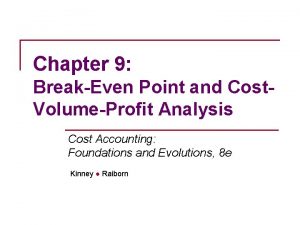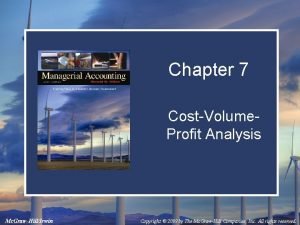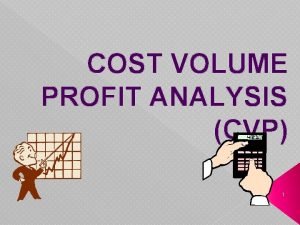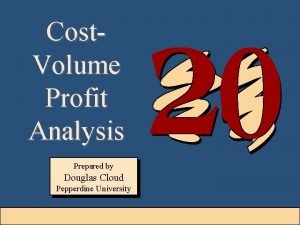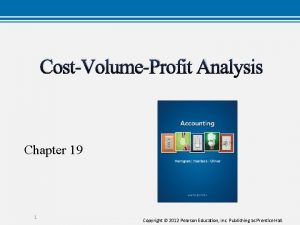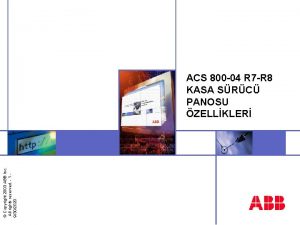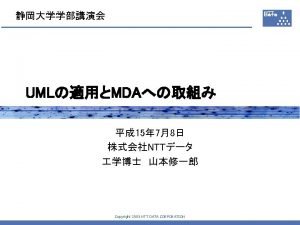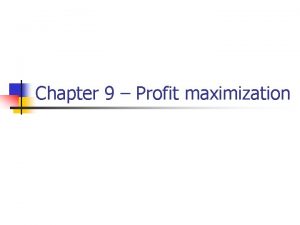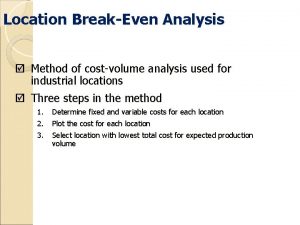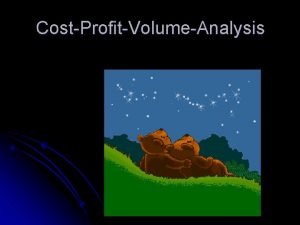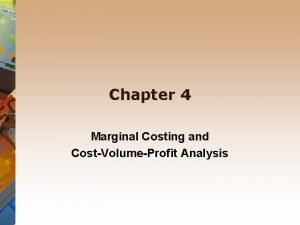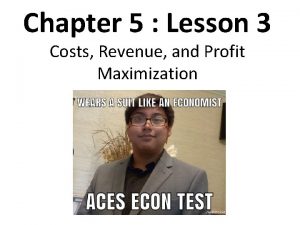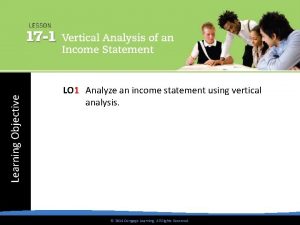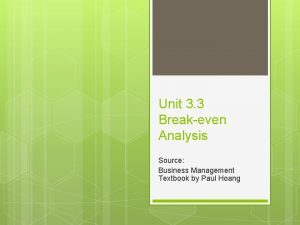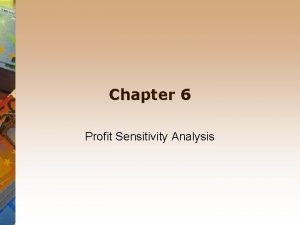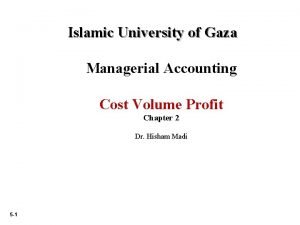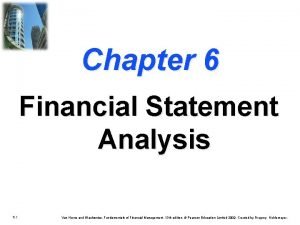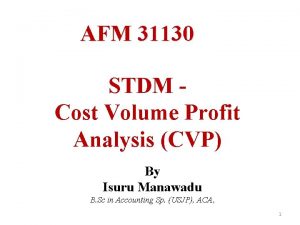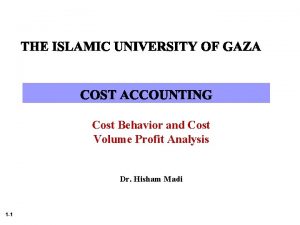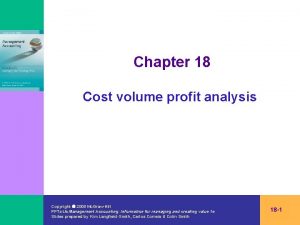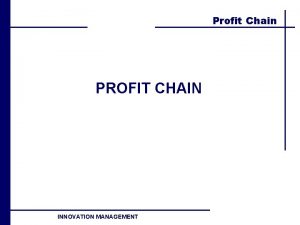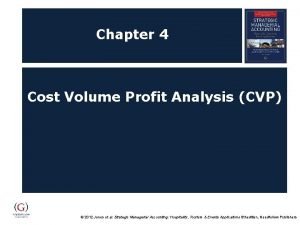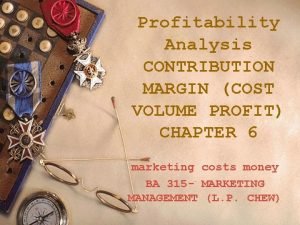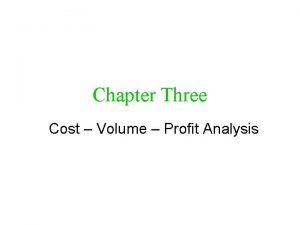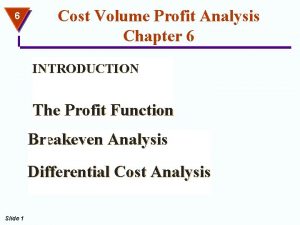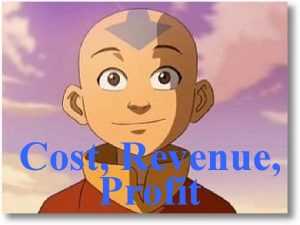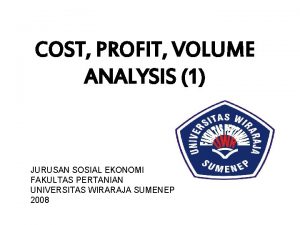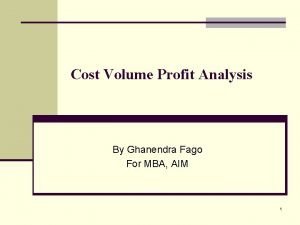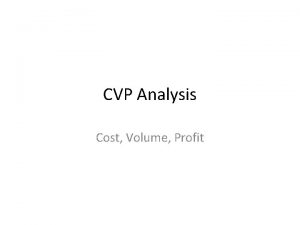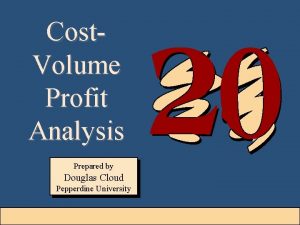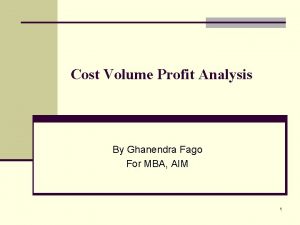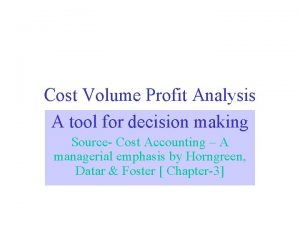Chapter 17 Cost volume profit analysis Copyright 2003






























- Slides: 30

Chapter 17 Cost volume profit analysis Copyright 2003 Mc. Graw-Hill Australia Pty Ltd, PPTs t/a Management Accounting: An Australian Perspective 3/e by Langfield-Smith, Thorne & Hilton Slides prepared by Kim Langfield-Smith 1

Cost volume profit (CVP) analysis s A technique used to determine the effects of changes in an organisation’s sales volume on its costs, revenue and profit s Can be used in profit-seeking and not-for profit organisations Copyright 2003 Mc. Graw-Hill Australia Pty Ltd, PPTs t/a Management Accounting: An Australian Perspective 3/e by Langfield-Smith, Thorne & Hilton Slides prepared by Kim Langfield-Smith 2

The break-even point s The volume of sales where the total revenues and expenses are equal, and the operation breaks even s Can be calculated for an entire organisation or individual projects or activities Copyright 2003 Mc. Graw-Hill Australia Pty Ltd, PPTs t/a Management Accounting: An Australian Perspective 3/e by Langfield-Smith, Thorne & Hilton Slides prepared by Kim Langfield-Smith 3

Formulas Copyright 2003 Mc. Graw-Hill Australia Pty Ltd, PPTs t/a Management Accounting: An Australian Perspective 3/e by Langfield-Smith, Thorne & Hilton Slides prepared by Kim Langfield-Smith 4

Terminology s Contribution margin (or variable costing) statement ÙA reporting format where costs are reported by cost behaviour and a contribution margin is calculated s Total contribution margin ÙThe difference between the sales revenue and the variable costs ÙThe amount available to cover fixed costs and then contribute to profits continued Copyright 2003 Mc. Graw-Hill Australia Pty Ltd, PPTs t/a Management Accounting: An Australian Perspective 3/e by Langfield-Smith, Thorne & Hilton Slides prepared by Kim Langfield-Smith 5

Terminology s Unit contribution margin ÙThe difference between the sales price per unit and variable cost per unit s Contribution margin ratio ÙThe unit contribution margin divided by the unit sales price ÙThe proportion of each sales dollar available to cover fixed costs and earn a profit continued Copyright 2003 Mc. Graw-Hill Australia Pty Ltd, PPTs t/a Management Accounting: An Australian Perspective 3/e by Langfield-Smith, Thorne & Hilton Slides prepared by Kim Langfield-Smith 6

Terminology s Contribution margin percentage ÙThe unit contribution margin ratio multiplied by 100 ÙThe percentage of each sales dollar available to cover fixed costs and earn a profit Copyright 2003 Mc. Graw-Hill Australia Pty Ltd, PPTs t/a Management Accounting: An Australian Perspective 3/e by Langfield-Smith, Thorne & Hilton Slides prepared by Kim Langfield-Smith 7

Cost volume profit (CVP) graph s Shows how costs, revenue and profits change as sales volume changes s Five steps ÙDraw the fixed expense line ÙDraw the total revenue line ÙBreak-even point—where the total revenue and total expense lines intersect Copyright 2003 Mc. Graw-Hill Australia Pty Ltd, PPTs t/a Management Accounting: An Australian Perspective 3/e by Langfield-Smith, Thorne & Hilton Slides prepared by Kim Langfield-Smith 8

Copyright 2003 Mc. Graw-Hill Australia Pty Ltd, PPTs t/a Management Accounting: An Australian Perspective 3/e by Langfield-Smith, Thorne & Hilton Slides prepared by Kim Langfield-Smith 9

Profit volume (PV) graph s Shows the total amount of profit or loss at different sales volumes s The graph intercept the vertical axis at the amount equal to the fixed costs s The break-even point is the point at which the line crosses the horizontal axis Copyright 2003 Mc. Graw-Hill Australia Pty Ltd, PPTs t/a Management Accounting: An Australian Perspective 3/e by Langfield-Smith, Thorne & Hilton Slides prepared by Kim Langfield-Smith 10

Copyright 2003 Mc. Graw-Hill Australia Pty Ltd, PPTs t/a Management Accounting: An Australian Perspective 3/e by Langfield-Smith, Thorne & Hilton Slides prepared by Kim Langfield-Smith 11

Target net profit s A desired profit level determined by management s Can be used within the break-even formula Copyright 2003 Mc. Graw-Hill Australia Pty Ltd, PPTs t/a Management Accounting: An Australian Perspective 3/e by Langfield-Smith, Thorne & Hilton Slides prepared by Kim Langfield-Smith 12

CVP analysis and management decision making s Common applications include ÙSafety margin ÙChanges in fixed expenses ÙChanges in the unit contribution margin ÙMultiple changes in key variables Copyright 2003 Mc. Graw-Hill Australia Pty Ltd, PPTs t/a Management Accounting: An Australian Perspective 3/e by Langfield-Smith, Thorne & Hilton Slides prepared by Kim Langfield-Smith 13

Safety margin s Difference between the budgeted sales revenue and the break-even sales revenue s Gives a feel for how close projected operations are to the break-even point Copyright 2003 Mc. Graw-Hill Australia Pty Ltd, PPTs t/a Management Accounting: An Australian Perspective 3/e by Langfield-Smith, Thorne & Hilton Slides prepared by Kim Langfield-Smith 14

Changes in fixed expenses s When estimates of fixed costs are revised, the break-even point will change ÙPercentage change in fixed expenses will lead to similar increase in the break-even point (in units or dollars) s Different fixed costs may apply to different levels of sales/production volume ÙMore than one break-even point Copyright 2003 Mc. Graw-Hill Australia Pty Ltd, PPTs t/a Management Accounting: An Australian Perspective 3/e by Langfield-Smith, Thorne & Hilton Slides prepared by Kim Langfield-Smith 15

Changes in the unit contribution margin s Change in unit variable expenses ÙChanges the unit contribution margin ÙA new break-even point ÙAn increase in unit variable expenses will increase the break-even point continued Copyright 2003 Mc. Graw-Hill Australia Pty Ltd, PPTs t/a Management Accounting: An Australian Perspective 3/e by Langfield-Smith, Thorne & Hilton Slides prepared by Kim Langfield-Smith 16

Changes in the unit contribution margin s Change in sales price ÙChanges the unit contribution margin ÙA new break-even point ÙAn increase in unit price will lower the breakeven point Copyright 2003 Mc. Graw-Hill Australia Pty Ltd, PPTs t/a Management Accounting: An Australian Perspective 3/e by Langfield-Smith, Thorne & Hilton Slides prepared by Kim Langfield-Smith 17

Multiple changes in key variables s May involve ÙIncreasing unit prices ÙUndertaking an advertising campaign ÙHiring a new storage facility s An incremental approach ÙFocuses on the difference in the total contribution margin, fixed expenses and profits under the two alternatives Copyright 2003 Mc. Graw-Hill Australia Pty Ltd, PPTs t/a Management Accounting: An Australian Perspective 3/e by Langfield-Smith, Thorne & Hilton Slides prepared by Kim Langfield-Smith 18

CVP analysis with multiple products s Sales mix ÙThe relative proportions of each type of product sold by the organisation s Weighted average unit contribution margin ÙThe average of the products’ unit contribution margins, weighted by the sales mix Copyright 2003 Mc. Graw-Hill Australia Pty Ltd, PPTs t/a Management Accounting: An Australian Perspective 3/e by Langfield-Smith, Thorne & Hilton Slides prepared by Kim Langfield-Smith 19

Including income taxes Copyright 2003 Mc. Graw-Hill Australia Pty Ltd, PPTs t/a Management Accounting: An Australian Perspective 3/e by Langfield-Smith, Thorne & Hilton Slides prepared by Kim Langfield-Smith 20

Assumptions underlying CVP analysis s The behaviour of total revenue is linear s The behaviour of total costs is linear over a relevant range ÙCosts can be categorised as fixed, variable or semivariable ÙLabour productivity, production technology and market conditions do not change ÙThere are no capacity changes during the period under consideration continued Copyright 2003 Mc. Graw-Hill Australia Pty Ltd, PPTs t/a Management Accounting: An Australian Perspective 3/e by Langfield-Smith, Thorne & Hilton Slides prepared by Kim Langfield-Smith 21

Assumptions underlying CVP analysis s For both variable and fixed costs, sales volume is the only cost driver s The sales mix remains constant over the relevant range s In manufacturing firms, levels of inventory at the beginning and end of the period are the same Copyright 2003 Mc. Graw-Hill Australia Pty Ltd, PPTs t/a Management Accounting: An Australian Perspective 3/e by Langfield-Smith, Thorne & Hilton Slides prepared by Kim Langfield-Smith 22

CVP analysis and longterm decisions s CVP analysis is usually regarded a shortterm or tactical decision tool s Classification of costs as variable or fixed is usually based on cost behaviour over the short-term s The financial impact of long-term decisions best analysed using capital budgeting techniques Copyright 2003 Mc. Graw-Hill Australia Pty Ltd, PPTs t/a Management Accounting: An Australian Perspective 3/e by Langfield-Smith, Thorne & Hilton Slides prepared by Kim Langfield-Smith 23

Treating CVP analysis with caution s CVP analysis is merely a simplified model s The usefulness of CVP analysis may be greater in less complex smaller firms, or stand-alone projects s For larger firms, CVP analysis can be valuable as a decision tool for the planning stages of new projects and ventures Copyright 2003 Mc. Graw-Hill Australia Pty Ltd, PPTs t/a Management Accounting: An Australian Perspective 3/e by Langfield-Smith, Thorne & Hilton Slides prepared by Kim Langfield-Smith 24

An activity-based approach to CVP analysis s ABC categorises activities as facility, product, batch or unit costs ÙFacility, product and batch activities are nonvolume activity costs Copyright 2003 Mc. Graw-Hill Australia Pty Ltd, PPTs t/a Management Accounting: An Australian Perspective 3/e by Langfield-Smith, Thorne & Hilton Slides prepared by Kim Langfield-Smith 25

Limiting assumption of using activity-based costs s Batch costs are based on likely production levels s New planned production levels lead to changes in the number of production batches, and changes in total non-volume activity costs -> new break-even or target profit volume Copyright 2003 Mc. Graw-Hill Australia Pty Ltd, PPTs t/a Management Accounting: An Australian Perspective 3/e by Langfield-Smith, Thorne & Hilton Slides prepared by Kim Langfield-Smith 26

Sensitivity analysis and CVP analysis s Sensitivity analysis ÙAn approach which examines how an outcome may change due to variations in the predicted data or underlying assumptions s Can be run using spreadsheet software, such as Excel continued Copyright 2003 Mc. Graw-Hill Australia Pty Ltd, PPTs t/a Management Accounting: An Australian Perspective 3/e by Langfield-Smith, Thorne & Hilton Slides prepared by Kim Langfield-Smith 27

continued Copyright 2003 Mc. Graw-Hill Australia Pty Ltd, PPTs t/a Management Accounting: An Australian Perspective 3/e by Langfield-Smith, Thorne & Hilton Slides prepared by Kim Langfield-Smith 28

Sensitivity analysis and CVP analysis s Goal seeking approaches ÙAllows the analyst to specify the outcome, so that software can specify the necessary inputs s What-if analysis ÙThe analyst specifies changes in assumptions to examine the effect of these changes on the output Copyright 2003 Mc. Graw-Hill Australia Pty Ltd, PPTs t/a Management Accounting: An Australian Perspective 3/e by Langfield-Smith, Thorne & Hilton Slides prepared by Kim Langfield-Smith 29

Copyright 2003 Mc. Graw-Hill Australia Pty Ltd, PPTs t/a Management Accounting: An Australian Perspective 3/e by Langfield-Smith, Thorne & Hilton Slides prepared by Kim Langfield-Smith 30
 Cost structure refers to the relative proportion of
Cost structure refers to the relative proportion of Break even sales dollars formula
Break even sales dollars formula Chapter 3 cost volume profit analysis
Chapter 3 cost volume profit analysis Cost volume profit analysis graph
Cost volume profit analysis graph Objectives of cost volume profit analysis
Objectives of cost volume profit analysis Cost volume profit
Cost volume profit Unit contribution margin equation
Unit contribution margin equation Copyright 2003
Copyright 2003 2008 pearson education inc
2008 pearson education inc Copyrightfrance
Copyrightfrance Copyright 2003
Copyright 2003 Accounting profit vs economic profit
Accounting profit vs economic profit Economic profit vs accounting profit
Economic profit vs accounting profit Post acquisition profit is which profit
Post acquisition profit is which profit Locational break even analysis example
Locational break even analysis example Locational cost volume analysis example
Locational cost volume analysis example Location planning management
Location planning management Profit volume graph
Profit volume graph Multi product profit volume chart
Multi product profit volume chart Profit volume chart example
Profit volume chart example Cost revenue and profit maximization guided reading
Cost revenue and profit maximization guided reading Linear cost function formula
Linear cost function formula Vertical analysis gross profit
Vertical analysis gross profit Contribution analysis table
Contribution analysis table Profit sensitivity analysis
Profit sensitivity analysis Profit analysis
Profit analysis Profit analysis
Profit analysis Profit analysis
Profit analysis End-diastolic volume vs end-systolic volume
End-diastolic volume vs end-systolic volume Stroke volume normal
Stroke volume normal Solute
Solute

